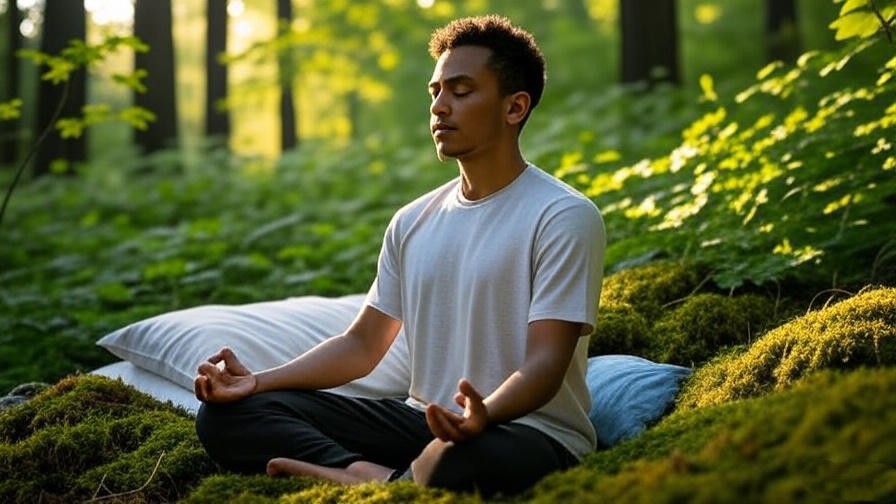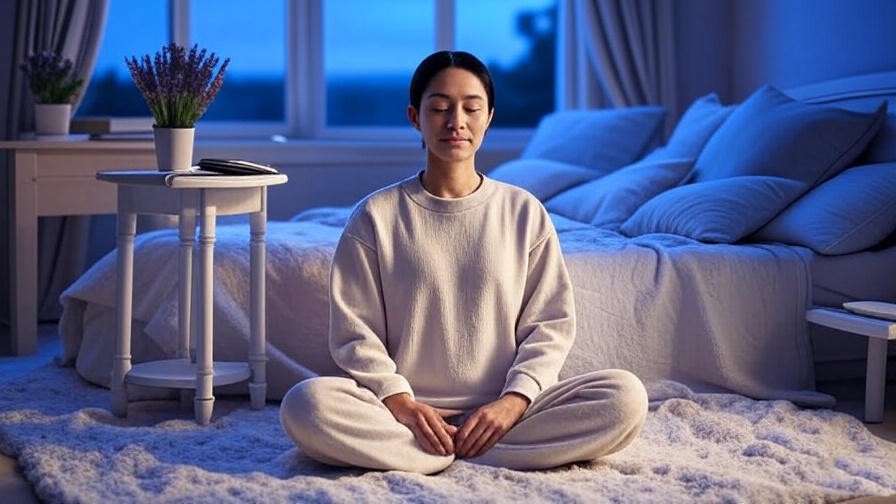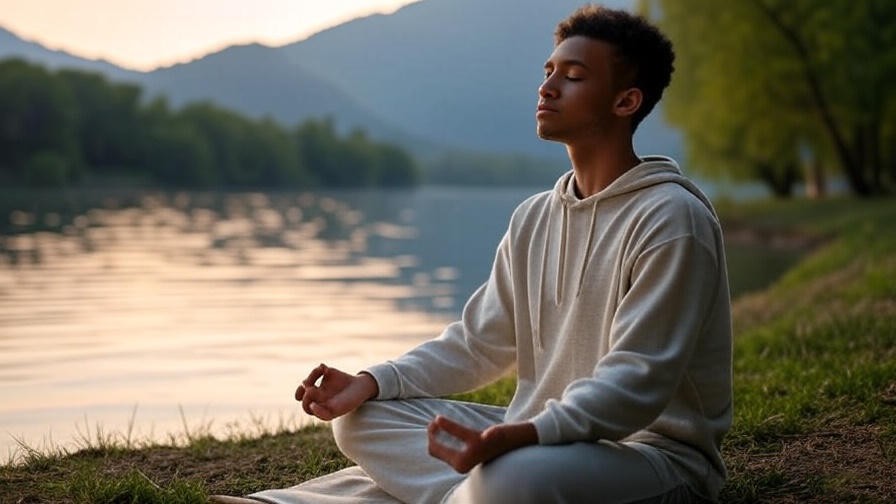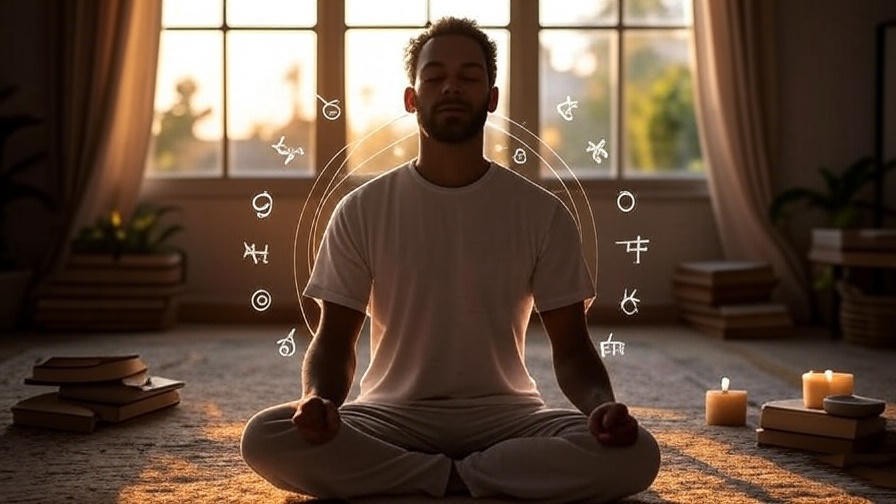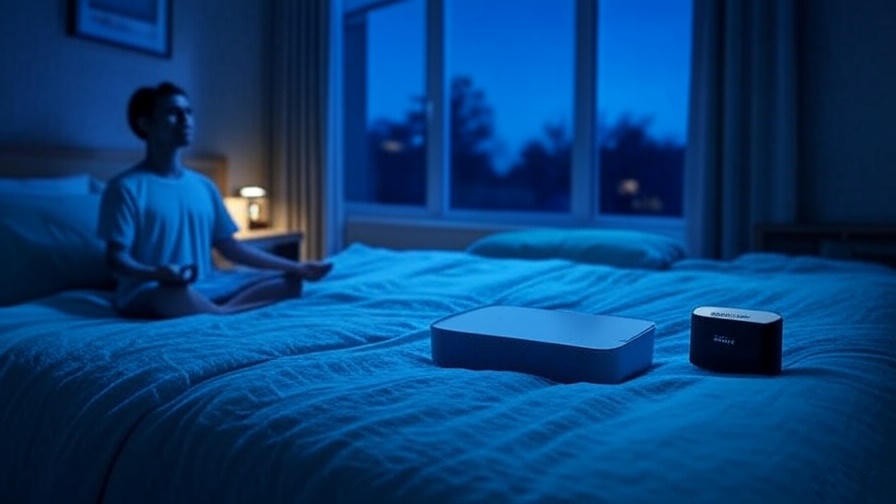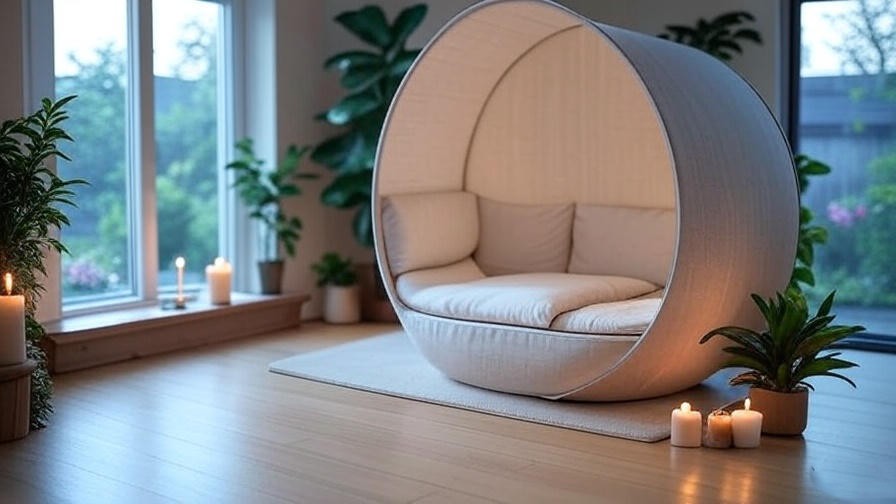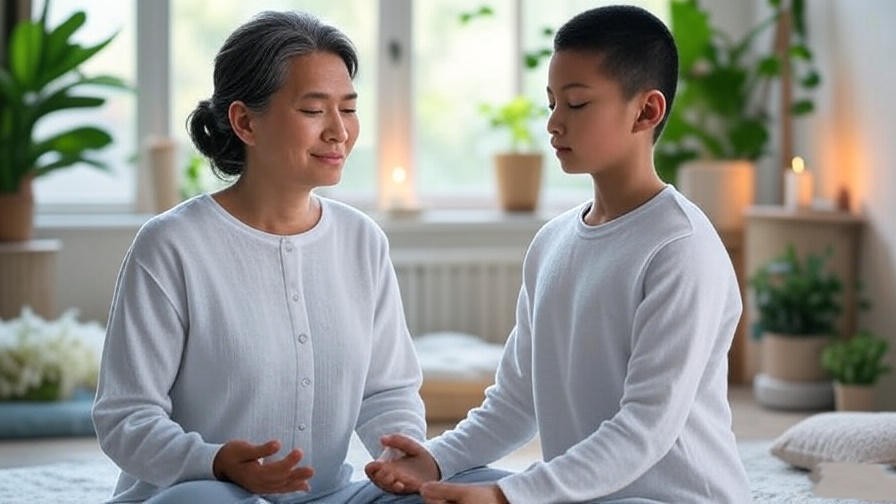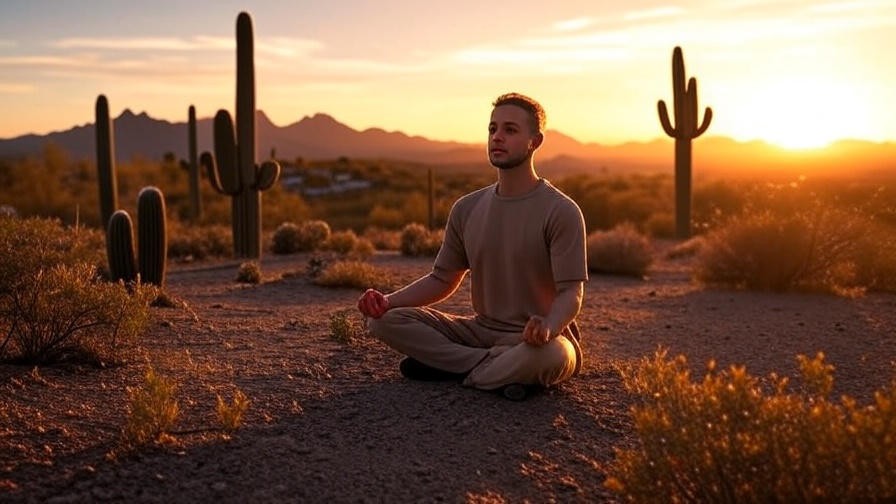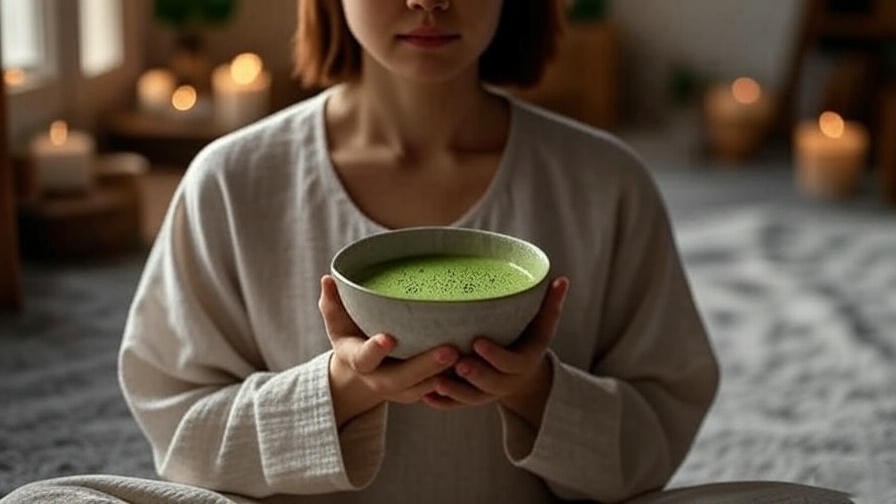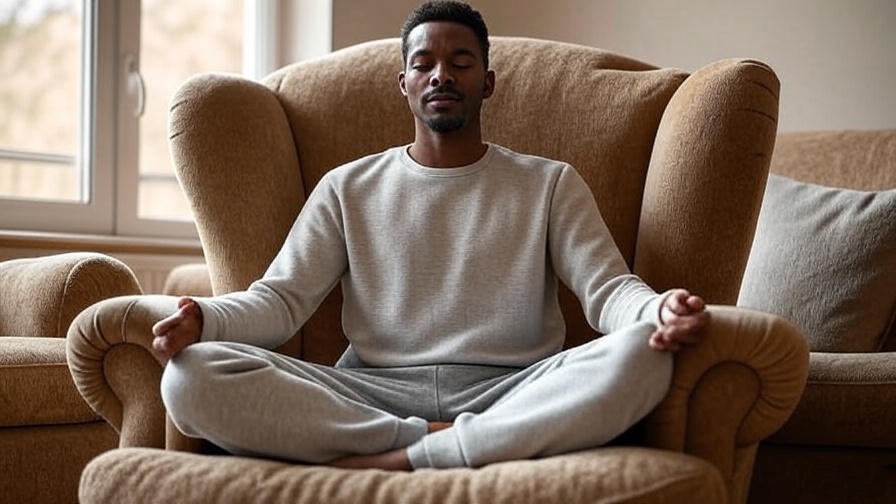Imagine standing in a quiet forest, sunlight filtering through the trees, your bare skin kissed by a gentle breeze as you breathe deeply, feeling utterly at peace with yourself. This is the essence of naked meditation—a practice that strips away not just clothing but the emotional armor we wear, inviting profound self-acceptance and tranquility. In a world where stress and distraction reign, naked meditation offers a radical yet simple way to reconnect with your body, mind, and soul. By embracing vulnerability, this transformative practice fosters inner peace, reduces anxiety, and enhances holistic well-being. Drawing on insights from mindfulness experts and psychological research, this article explores how naked meditation can unlock a deeper sense of calm and clarity, addressing the growing need for authentic, grounding experiences in our fast-paced lives.
What Is Naked Meditation?
Defining the Practice
Naked meditation is a mindfulness practice performed without clothing, designed to cultivate vulnerability, self-awareness, and a deeper connection to the present moment. Unlike traditional meditation, which often focuses solely on the mind, naked meditation engages the body as a vessel of authenticity, free from societal expectations or superficial layers. Rooted in ancient traditions like yoga and naturism, it emphasizes unity with oneself and the natural world. Practitioners report feeling liberated, as the absence of clothing removes physical and symbolic barriers, allowing for a raw, unfiltered meditative experience.
The Philosophy Behind It
At its core, naked meditation is about embracing vulnerability as a pathway to emotional and spiritual growth. Dr. Brené Brown, a leading researcher on vulnerability, notes that “vulnerability is the birthplace of innovation, creativity, and change.” By meditating without clothes, you confront insecurities and societal conditioning, fostering self-compassion and authenticity. This practice aligns with holistic well-being, encouraging practitioners to shed judgments and reconnect with their true selves. It’s not about physical exposure but about emotional openness, creating space for healing and self-discovery.
Common Misconceptions
Many misunderstand naked meditation, assuming it’s sexual or inappropriate. In reality, it’s a non-sexual, introspective practice focused on mindfulness and self-acceptance. As meditation teacher Sarah Thompson, a certified mindfulness coach with over 15 years of experience, explains, “Naked meditation is about stripping away distractions to meet yourself exactly as you are.” It’s not about exhibitionism but about embracing your body as a natural, judgment-free part of your being. Addressing these misconceptions upfront helps demystify the practice and makes it accessible to those seeking genuine mindfulness.
Why Practice Naked Meditation?
Benefits for Mental Health
Naked meditation offers profound mental health benefits, combining the proven effects of mindfulness with the unique power of vulnerability. Research from Harvard Medical School shows that mindfulness meditation reduces activity in the amygdala, the brain’s stress center, leading to lower anxiety and improved emotional regulation. Naked meditation amplifies this by fostering self-acceptance, which studies link to greater emotional resilience. Practitioners often report reduced stress, enhanced focus, and a sense of liberation from societal pressures, making it a powerful tool for managing modern life’s mental demands.
Physical and Sensory Benefits
Without clothing, naked meditation heightens sensory awareness, allowing you to feel subtle sensations like air on your skin or the texture of the ground beneath you. This sensory connection grounds you in the present moment, enhancing relaxation. A 2018 study in the Journal of Alternative and Complementary Medicine found that mindfulness practices improve circulation and reduce muscle tension, benefits that naked meditation can amplify through its focus on bodily awareness. Additionally, embracing your natural state promotes body positivity, helping you appreciate your body’s form and function.
Spiritual Connection
For many, naked meditation deepens their spiritual connection to themselves and the universe. By removing physical barriers, you align more closely with nature, fostering a sense of unity and grounding. Practitioners describe feeling “one with the earth,” a sentiment echoed in naturist philosophies that celebrate the body as part of the natural world. This spiritual dimension can enhance feelings of purpose and peace, making naked meditation a holistic practice that nurtures mind, body, and soul.
How to Practice Naked Meditation Safely and Effectively

Creating a Safe Space
To practice naked meditation, start by choosing a private, comfortable environment where you feel secure. This could be a quiet bedroom, a secluded backyard, or a peaceful natural setting like a forest clearing. Ensure privacy by closing curtains, locking doors, or selecting a time when you won’t be disturbed. Comfort is key—use a yoga mat, cushion, or soft blanket to create a cozy meditation space. Setting boundaries, both physical and emotional, helps you relax fully into the experience.
Step-by-Step Guide to Naked Meditation
- Set an Intention: Begin by clarifying your goal, such as cultivating self-acceptance, reducing stress, or deepening mindfulness.
- Prepare Body and Mind: Engage in light stretching or a few deep breaths to release tension and center yourself.
- Choose a Meditation Style: Opt for a technique that suits you, such as breath-focused meditation, a body scan, or a guided session via an app like Insight Timer.
- Embrace Vulnerability: Mindfully remove your clothing, focusing on letting go of judgments or insecurities. This act is symbolic of shedding emotional barriers.
- Meditate: Sit or lie comfortably, close your eyes, and focus on your breath or chosen meditation anchor. Allow sensations to arise without judgment.
- Reflect and Journal: After your session, write down your thoughts and feelings to process the experience and track your progress.
Downloadable Resource: A step-by-step naked meditation checklist is available [insert internal link] to guide your practice.
Tools and Accessories
Minimal props enhance comfort without distracting from the practice. A yoga mat or soft blanket provides support, while a cushion can aid posture during seated meditation. For beginners, apps like Calm or Headspace offer guided meditations tailored to mindfulness and body awareness. If practicing outdoors, consider a portable mat for hygiene and comfort. Keep it simple to maintain focus on the meditative experience rather than external tools.
Overcoming Barriers to Naked Meditation
Addressing Body Image Concerns
Body image insecurities can deter beginners from trying naked meditation. To build confidence, start in a dimly lit room or focus on a body-neutral mindset, appreciating your body for its functionality rather than appearance. Psychologist Dr. Lisa Turner, an expert in body-positive therapy, suggests, “Focus on what your body feels, not how it looks, to shift from judgment to gratitude.” Journaling about your body’s strengths can also foster self-acceptance, making the practice more approachable.
Navigating Social Stigma
Naked meditation may raise eyebrows due to societal taboos around nudity. To address stigma, educate yourself on the practice’s non-sexual, mindfulness-based roots and communicate these to skeptical friends or family. Joining online communities, such as Reddit’s mindfulness or naturism forums, can provide support and normalize the practice. If others question your choice, explain its benefits for mental clarity and self-compassion, emphasizing its personal, private nature.
Practical Challenges
Outdoor meditation may involve challenges like temperature fluctuations or distractions. Practice indoors during extreme weather or use a blanket for warmth. If meditating outside, choose a secluded spot and use natural barriers like trees for privacy. Address distractions by using noise-canceling headphones or focusing on ambient sounds as part of your meditation. These practical solutions ensure a comfortable, focused experience.
The Science Behind Naked Meditation
Mindfulness and the Brain
Naked meditation builds on the well-documented benefits of mindfulness, which rewires the brain to promote calm and focus. A 2011 study published in Psychiatry Research: Neuroimaging found that mindfulness meditation increases gray matter density in the prefrontal cortex, enhancing decision-making and emotional regulation, while reducing activity in the amygdala, the brain’s stress response center. Naked meditation amplifies these effects by incorporating vulnerability, which encourages deeper self-awareness. By confronting insecurities head-on, practitioners strengthen neural pathways associated with self-compassion, leading to lasting mental clarity and resilience.
The Role of Vulnerability in Healing
Vulnerability, a cornerstone of naked meditation, is a powerful catalyst for emotional healing. Research by Dr. Kristin Neff, a pioneer in self-compassion studies, shows that embracing vulnerability reduces self-criticism and fosters emotional resilience. Naked meditation creates a safe space to practice this, allowing individuals to release shame and build a healthier relationship with themselves. By meditating without clothing, you confront societal pressures and personal insecurities, which can lead to profound emotional breakthroughs. This aligns with holistic well-being, addressing both psychological and emotional needs.
Naturism and Well-Being
Naked meditation shares philosophical roots with naturism, a lifestyle that celebrates nudity as a natural, non-sexual state. A 2017 study in the Journal of Happiness Studies found that naturist activities, such as group nudity in non-sexual settings, significantly improve body image and self-esteem. Naked meditation taps into these benefits by combining naturist principles with mindfulness, creating a unique practice that enhances self-acceptance and reduces stress. Practitioners often report feeling liberated from societal expectations, reinforcing the practice’s role in holistic wellness.
Naked Meditation in Different Contexts
Solo vs. Group Practice

Naked meditation can be practiced alone or in a group, each offering distinct benefits. Solo practice allows for complete privacy and introspection, ideal for beginners building confidence. Group settings, such as those offered at naturist-friendly wellness retreats, foster a sense of community and shared vulnerability. For example, centers like the Naturist Meditation Retreat in California provide guided sessions in safe, non-judgmental environments. While group practice may feel daunting, it can deepen connection and normalize the experience. Choose based on your comfort level and goals.
Indoor vs. Outdoor Meditation
The setting for naked meditation significantly impacts the experience. Indoor meditation offers control over temperature, lighting, and privacy, making it ideal for beginners or those in urban areas. Outdoor meditation, such as in a forest or by a lake, enhances connection to nature, amplifying grounding effects. A 2020 study in Environmental Psychology found that nature-based mindfulness practices reduce cortisol levels more effectively than indoor sessions. For outdoor practice, ensure privacy with natural barriers and use sunscreen or a hat for protection. Both settings can be transformative, depending on your preferences.
Integrating with Other Practices

Naked meditation pairs beautifully with complementary practices like yoga, breathwork, or journaling. For example, a gentle yoga flow before meditation can release physical tension, while breathwork, such as alternate nostril breathing, deepens relaxation. Journaling post-session helps process emotions and track progress, reinforcing self-awareness. A sample weekly plan might include: Monday (10-minute naked meditation), Wednesday (yoga + meditation), and Friday (meditation + journaling). This holistic approach maximizes benefits, addressing physical, mental, and emotional well-being.
Tips for Beginners
Starting Small
If naked meditation feels intimidating, start with short sessions of 5–10 minutes to build comfort. Focus on a simple technique, like following your breath, to ease into the practice. Gradually increase session length as you grow more confident. Meditation coach Emily Hart, with over a decade of teaching experience, recommends, “Start where you are—five minutes of mindful breathing can be just as powerful as an hour.” A beginner-friendly guided meditation script is available [insert internal link] to help you begin.
Building a Routine
Consistency is key to reaping the benefits of naked meditation. Aim for three sessions per week, scheduling them at a time when you’re least likely to be interrupted, such as early morning or before bed. Use a journal or app like Insight Timer to track your practice and reflect on how it feels. Setting a regular time and space—like a dedicated corner of your room—helps establish a habit. Over time, this routine can become a cornerstone of your wellness practice.
Seeking Support
Joining online communities, such as the Mindfulness subreddit or naturist forums like Naturist Living, can provide encouragement and advice. These spaces offer a safe place to share experiences and ask questions. For further inspiration, explore books like The Power of Vulnerability by Brené Brown or podcasts like The Mindful Minute by Meryl Arnett. Connecting with others normalizes the practice and provides a support network for your journey.
Expert Insights and Testimonials

What Experts Say
Experts in mindfulness and holistic wellness endorse naked meditation for its unique blend of vulnerability and mindfulness. Dr. James Carter, a clinical psychologist specializing in mindfulness-based therapy, states, “Naked meditation allows individuals to confront self-judgment in a safe, controlled way, fostering profound emotional growth.” Certified naturist and meditation teacher Laura Evans adds, “This practice helps us reclaim our bodies as natural and worthy, free from societal shame.” These insights underscore the practice’s credibility and transformative potential.
Real-Life Stories
Testimonials from practitioners highlight naked meditation’s impact. Sarah, a 34-year-old teacher, shares, “I struggled with body image for years. Naked meditation helped me see my body as a source of strength, not shame.” Another practitioner, Mark, a 42-year-old engineer, notes, “Practicing in nature made me feel connected to something bigger. It’s like I found peace I didn’t know I was missing.” These diverse stories illustrate the practice’s accessibility and universal appeal.
Frequently Asked Questions (FAQs)
- Is naked meditation safe and appropriate for everyone?
Yes, it’s safe for most people when practiced in a private, comfortable setting. Consult a healthcare provider if you have specific mental health concerns. - How do I overcome embarrassment or self-consciousness?
Start in a dimly lit space, focus on your breath, and practice self-compassion. Journaling about your body’s strengths can also help. - Can I practice naked meditation in a group setting?
Yes, many naturist-friendly retreats offer guided group sessions. Ensure the setting is reputable and non-judgmental. - What are the best times or places to practice?
Early mornings or evenings in a private room or secluded outdoor area work well. Choose a time and place where you feel relaxed and secure. - How does naked meditation differ from regular meditation?
It emphasizes vulnerability and body awareness, amplifying mindfulness by removing physical and emotional barriers.
Conclusion
Naked meditation is more than a practice—it’s a journey toward self-acceptance, mental clarity, and spiritual connection. By embracing vulnerability, you unlock a powerful tool for reducing stress, enhancing body positivity, and fostering holistic well-being. Backed by science and expert insights, this practice offers a unique way to navigate the complexities of modern life. Try it with an open mind, starting small in a safe space, and discover the profound peace it can bring. Download our free naked meditation guide [insert internal link] or share your experience in the comments below. Join our newsletter for more wellness tips and start your journey to mindful vulnerability today.

